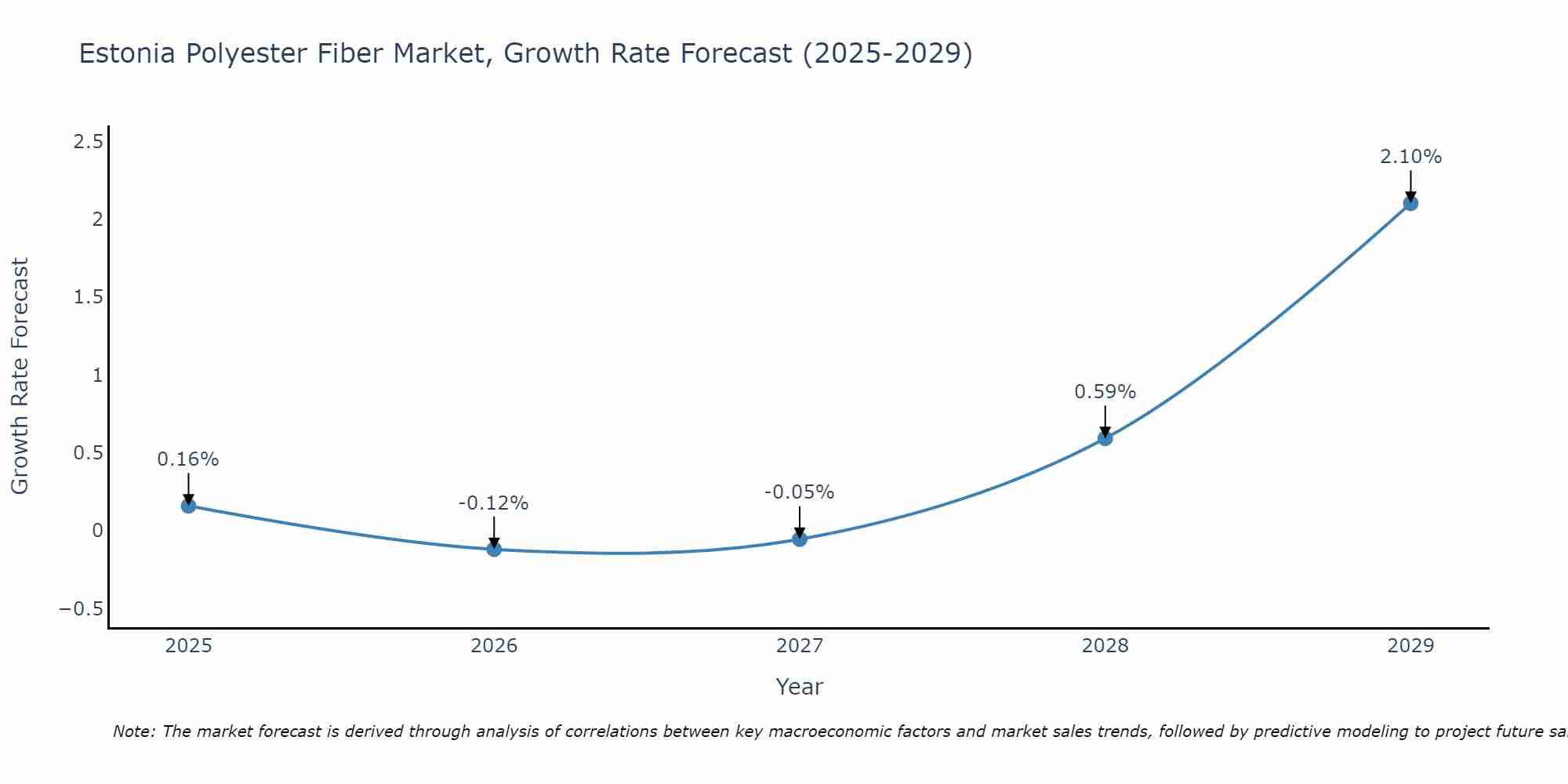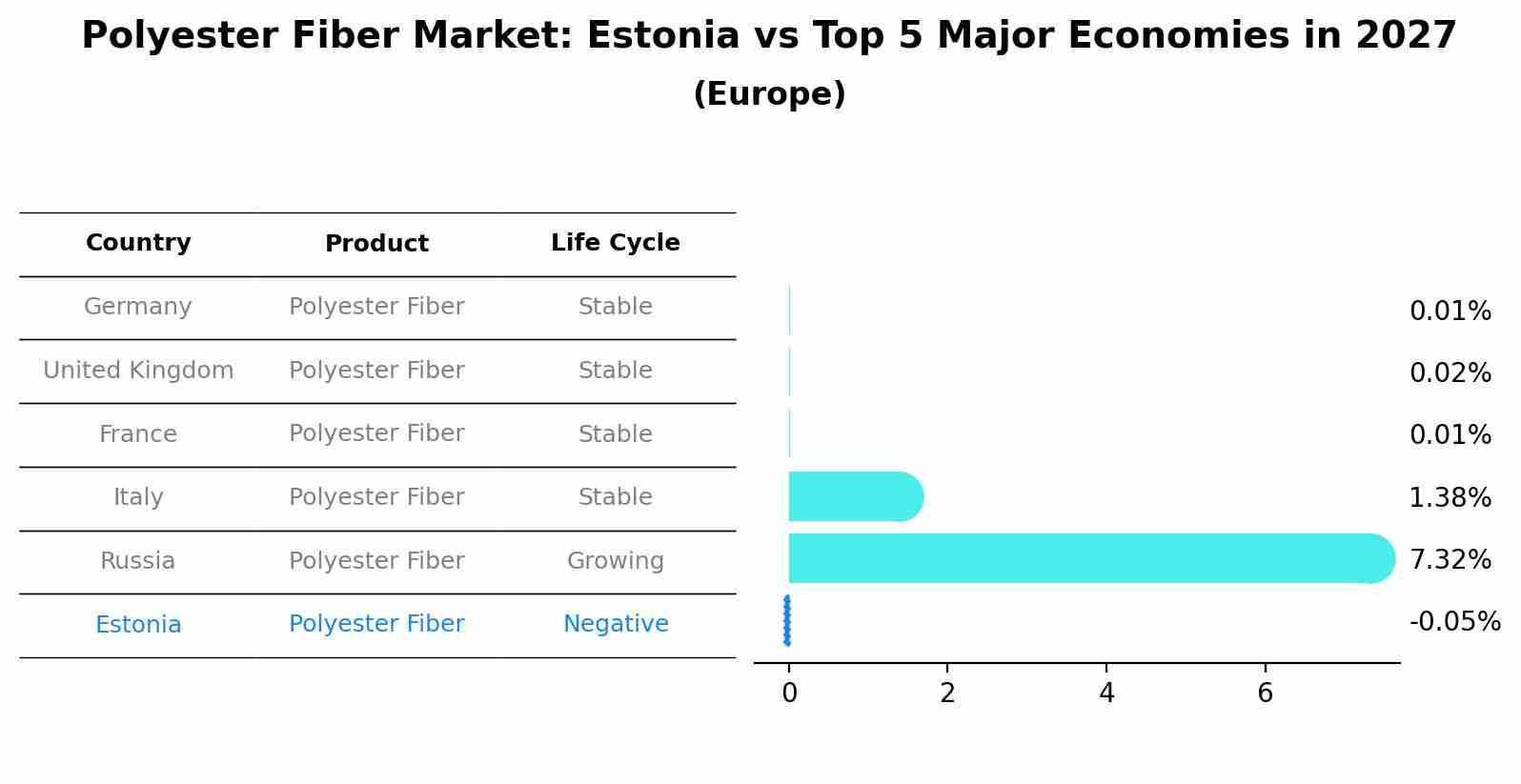Estonia Polyester Fiber Market (2025-2031) | Growth, Segmentation, Size, Analysis, Trends, Forecast, Companies, Outlook, Revenue, Industry, Share & Value
| Product Code: ETC5053500 | Publication Date: Nov 2023 | Updated Date: Apr 2025 | Product Type: Market Research Report | |
| Publisher: 6Wresearch | Author: Sachin Kumar Rai | No. of Pages: 60 | No. of Figures: 30 | No. of Tables: 5 |
Estonia Polyester Fiber Market Size Growth Rate
The Estonia Polyester Fiber Market is projected to witness mixed growth rate patterns during 2025 to 2029. From 0.16% in 2025, the growth rate steadily ascends to 2.10% in 2029.

Polyester Fiber Market: Estonia vs Top 5 Major Economies in 2027 (Europe)
The Polyester Fiber market in Estonia is projected to grow at a negative growth rate of -0.05% by 2027, highlighting the country's increasing focus on advanced technologies within the Europe region, where Germany holds the dominant position, followed closely by United Kingdom, France, Italy and Russia, shaping overall regional demand.

Estonia Polyester Fiber Market Overview
The polyester fiber market in Estonia is growing due to its widespread use in textiles, apparel, and home furnishings. Polyester fibers are known for their durability, ease of care, and cost-effectiveness. As the fashion and textile industries evolve in Estonia, the demand for polyester fibers is expected to rise, supported by trends toward sustainable and high-performance fabrics.
Drivers of the market
The polyester fiber market in Estonia is driven by the textile and apparel industry`s demand for durable, low-maintenance fabrics. Polyester fibers are widely used in the production of clothing, home textiles, and industrial fabrics due to their affordability, strength, and resistance to shrinkage and wrinkles. As the fashion and textile industries in Estonia continue to innovate with new fabric blends and sustainable practices, the demand for polyester fiber remains strong. The increasing trend toward recycling polyester fibers also contributes to market growth, as eco-conscious consumers and businesses seek more sustainable textile solutions.
Challenges of the market
The polyester fiber market in Estonia faces challenges stemming from the fluctuating prices of raw materials, environmental impact concerns, and competition from natural fibers. Polyester is the most widely used synthetic fiber, but its production is energy-intensive and dependent on petrochemical feedstocks. Rising awareness of environmental issues and the growing demand for sustainable textiles are pushing the industry to find alternative, eco-friendly solutions. Additionally, the growing popularity of natural fibers, such as cotton and wool, presents increasing competition to the polyester fiber market.
Government Policy of the market
Estonias polyester fiber market is driven by policies aimed at promoting the use of synthetic fibers in the textile and automotive industries. The government supports innovation in the development of more sustainable polyester fibers, such as recycled PET fibers, which help reduce waste and energy consumption. Regulations focus on ensuring that polyester fibers meet environmental standards, with an emphasis on reducing the use of harmful chemicals in production.
Key Highlights of the Report:
- Estonia Polyester Fiber Market Outlook
- Market Size of Estonia Polyester Fiber Market, 2024
- Forecast of Estonia Polyester Fiber Market, 2031
- Historical Data and Forecast of Estonia Polyester Fiber Revenues & Volume for the Period 2021-2031
- Estonia Polyester Fiber Market Trend Evolution
- Estonia Polyester Fiber Market Drivers and Challenges
- Estonia Polyester Fiber Price Trends
- Estonia Polyester Fiber Porter`s Five Forces
- Estonia Polyester Fiber Industry Life Cycle
- Historical Data and Forecast of Estonia Polyester Fiber Market Revenues & Volume By Grade for the Period 2021-2031
- Historical Data and Forecast of Estonia Polyester Fiber Market Revenues & Volume By PET for the Period 2021-2031
- Historical Data and Forecast of Estonia Polyester Fiber Market Revenues & Volume By PCDT for the Period 2021-2031
- Historical Data and Forecast of Estonia Polyester Fiber Market Revenues & Volume By Product for the Period 2021-2031
- Historical Data and Forecast of Estonia Polyester Fiber Market Revenues & Volume By Solid for the Period 2021-2031
- Historical Data and Forecast of Estonia Polyester Fiber Market Revenues & Volume By Hollow for the Period 2021-2031
- Historical Data and Forecast of Estonia Polyester Fiber Market Revenues & Volume By Application for the Period 2021-2031
- Historical Data and Forecast of Estonia Polyester Fiber Market Revenues & Volume By Carpets & rugs for the Period 2021-2031
- Historical Data and Forecast of Estonia Polyester Fiber Market Revenues & Volume By Non-woven fiber for the Period 2021-2031
- Historical Data and Forecast of Estonia Polyester Fiber Market Revenues & Volume By Fiberfill for the Period 2021-2031
- Historical Data and Forecast of Estonia Polyester Fiber Market Revenues & Volume By Apparel for the Period 2021-2031
- Historical Data and Forecast of Estonia Polyester Fiber Market Revenues & Volume By Home textile for the Period 2021-2031
- Historical Data and Forecast of Estonia Polyester Fiber Market Revenues & Volume By Others for the Period 2021-2031
- Estonia Polyester Fiber Import Export Trade Statistics
- Market Opportunity Assessment By Grade
- Market Opportunity Assessment By Product
- Market Opportunity Assessment By Application
- Estonia Polyester Fiber Top Companies Market Share
- Estonia Polyester Fiber Competitive Benchmarking By Technical and Operational Parameters
- Estonia Polyester Fiber Company Profiles
- Estonia Polyester Fiber Key Strategic Recommendations
Frequently Asked Questions About the Market Study (FAQs):
1 Executive Summary |
2 Introduction |
2.1 Key Highlights of the Report |
2.2 Report Description |
2.3 Market Scope & Segmentation |
2.4 Research Methodology |
2.5 Assumptions |
3 Estonia Polyester Fiber Market Overview |
3.1 Estonia Country Macro Economic Indicators |
3.2 Estonia Polyester Fiber Market Revenues & Volume, 2021 & 2031F |
3.3 Estonia Polyester Fiber Market - Industry Life Cycle |
3.4 Estonia Polyester Fiber Market - Porter's Five Forces |
3.5 Estonia Polyester Fiber Market Revenues & Volume Share, By Grade, 2021 & 2031F |
3.6 Estonia Polyester Fiber Market Revenues & Volume Share, By Product, 2021 & 2031F |
3.7 Estonia Polyester Fiber Market Revenues & Volume Share, By Application, 2021 & 2031F |
4 Estonia Polyester Fiber Market Dynamics |
4.1 Impact Analysis |
4.2 Market Drivers |
4.3 Market Restraints |
5 Estonia Polyester Fiber Market Trends |
6 Estonia Polyester Fiber Market Segmentations |
6.1 Estonia Polyester Fiber Market, By Grade |
6.1.1 Overview and Analysis |
6.1.2 Estonia Polyester Fiber Market Revenues & Volume, By PET, 2021-2031F |
6.1.3 Estonia Polyester Fiber Market Revenues & Volume, By PCDT, 2021-2031F |
6.2 Estonia Polyester Fiber Market, By Product |
6.2.1 Overview and Analysis |
6.2.2 Estonia Polyester Fiber Market Revenues & Volume, By Solid, 2021-2031F |
6.2.3 Estonia Polyester Fiber Market Revenues & Volume, By Hollow, 2021-2031F |
6.3 Estonia Polyester Fiber Market, By Application |
6.3.1 Overview and Analysis |
6.3.2 Estonia Polyester Fiber Market Revenues & Volume, By Carpets & rugs, 2021-2031F |
6.3.3 Estonia Polyester Fiber Market Revenues & Volume, By Non-woven fiber, 2021-2031F |
6.3.4 Estonia Polyester Fiber Market Revenues & Volume, By Fiberfill, 2021-2031F |
6.3.5 Estonia Polyester Fiber Market Revenues & Volume, By Apparel, 2021-2031F |
6.3.6 Estonia Polyester Fiber Market Revenues & Volume, By Home textile, 2021-2031F |
6.3.7 Estonia Polyester Fiber Market Revenues & Volume, By Others, 2021-2031F |
7 Estonia Polyester Fiber Market Import-Export Trade Statistics |
7.1 Estonia Polyester Fiber Market Export to Major Countries |
7.2 Estonia Polyester Fiber Market Imports from Major Countries |
8 Estonia Polyester Fiber Market Key Performance Indicators |
9 Estonia Polyester Fiber Market - Opportunity Assessment |
9.1 Estonia Polyester Fiber Market Opportunity Assessment, By Grade, 2021 & 2031F |
9.2 Estonia Polyester Fiber Market Opportunity Assessment, By Product, 2021 & 2031F |
9.3 Estonia Polyester Fiber Market Opportunity Assessment, By Application, 2021 & 2031F |
10 Estonia Polyester Fiber Market - Competitive Landscape |
10.1 Estonia Polyester Fiber Market Revenue Share, By Companies, 2024 |
10.2 Estonia Polyester Fiber Market Competitive Benchmarking, By Operating and Technical Parameters |
11 Company Profiles |
12 Recommendations | 13 Disclaimer |
- Single User License$ 1,995
- Department License$ 2,400
- Site License$ 3,120
- Global License$ 3,795
Search
Related Reports
- Europe Flooring Market (2025-2031) | Outlook, Share, Industry, Trends, Forecast, Companies, Revenue, Size, Analysis, Growth & Value
- Saudi Arabia Manlift Market (2025-2031) | Outlook, Size, Growth, Trends, Companies, Industry, Revenue, Value, Share, Forecast & Analysis
- Uganda Excavator, Crane, and Wheel Loaders Market (2025-2031) | Strategy, Consumer Insights, Analysis, Investment Trends, Opportunities, Growth, Size, Share, Industry, Revenue, Segments, Value, Segmentation, Supply, Forecast, Restraints, Outlook, Competition, Drivers, Trends, Demand, Pricing Analysis, Competitive, Strategic Insights, Companies, Challenges
- Rwanda Excavator, Crane, and Wheel Loaders Market (2025-2031) | Strategy, Consumer Insights, Analysis, Investment Trends, Opportunities, Growth, Size, Share, Industry, Revenue, Segments, Value, Segmentation, Supply, Forecast, Restraints, Outlook, Competition, Drivers, Trends, Demand, Pricing Analysis, Competitive, Strategic Insights, Companies, Challenges
- Kenya Excavator, Crane, and Wheel Loaders Market (2025-2031) | Strategy, Consumer Insights, Analysis, Investment Trends, Opportunities, Growth, Size, Share, Industry, Revenue, Segments, Value, Segmentation, Supply, Forecast, Restraints, Outlook, Competition, Drivers, Trends, Demand, Pricing Analysis, Competitive, Strategic Insights, Companies, Challenges
- Angola Excavator, Crane, and Wheel Loaders Market (2025-2031) | Strategy, Consumer Insights, Analysis, Investment Trends, Opportunities, Growth, Size, Share, Industry, Revenue, Segments, Value, Segmentation, Supply, Forecast, Restraints, Outlook, Competition, Drivers, Trends, Demand, Pricing Analysis, Competitive, Strategic Insights, Companies, Challenges
- Israel Intelligent Transport System Market (2025-2031) | Strategy, Consumer Insights, Analysis, Investment Trends, Opportunities, Growth, Size, Share, Industry, Revenue, Segments, Value, Segmentation, Supply, Forecast, Restraints, Outlook, Competition, Drivers, Trends, Demand, Pricing Analysis, Competitive, Strategic Insights, Companies, Challenges
- Uganda Precast and Aggregate Market (2025-2031) | Strategy, Consumer Insights, Analysis, Investment Trends, Opportunities, Growth, Size, Share, Industry, Revenue, Segments, Value, Segmentation, Supply, Forecast, Restraints, Outlook, Competition, Drivers, Trends, Demand, Pricing Analysis, Competitive, Strategic Insights, Companies, Challenges
- Australia IT Asset Disposal Market (2025-2031) | Strategy, Consumer Insights, Analysis, Investment Trends, Opportunities, Growth, Size, Share, Industry, Revenue, Segments, Value, Segmentation, Supply, Forecast, Restraints, Outlook, Competition, Drivers, Trends, Demand, Pricing Analysis, Competitive, Strategic Insights, Companies, Challenges
- UAE Building Thermal Insulation Market Outlook (2025-2031) | Revenue, Companies, Share, Trends, Growth, Size, Forecast, Industry, Analysis & Value
Industry Events and Analyst Meet
Our Clients
Whitepaper
- Middle East & Africa Commercial Security Market Click here to view more.
- Middle East & Africa Fire Safety Systems & Equipment Market Click here to view more.
- GCC Drone Market Click here to view more.
- Middle East Lighting Fixture Market Click here to view more.
- GCC Physical & Perimeter Security Market Click here to view more.
6WResearch In News
- Doha a strategic location for EV manufacturing hub: IPA Qatar
- Demand for luxury TVs surging in the GCC, says Samsung
- Empowering Growth: The Thriving Journey of Bangladesh’s Cable Industry
- Demand for luxury TVs surging in the GCC, says Samsung
- Video call with a traditional healer? Once unthinkable, it’s now common in South Africa
- Intelligent Buildings To Smooth GCC’s Path To Net Zero













